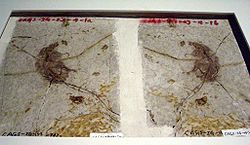Sinodelphys
Sinodelphys [1] is an extinct mammal from the Lower Cretaceous. It is a member of the infraclass Metatheria, the group which contains modern marsupials.
| Sinodelphys Temporal range: Lower Cretaceous
| |
|---|---|

| |
| Sinodelphys szalayi fossil displayed in Hong Kong Science Museum. | |
| Scientific classification | |
| Domain: | |
| Kingdom: | |
| Phylum: | |
| Class: | |
| Subclass: | |
| Infraclass: | |
| Genus: | †Sinodelphys
|
| Species: | †S. szalayi
|
To date, it is the oldest metatherian fossil known, estimated to be 125 million years old. This makes it almost contemporary to the earliest placental fossils, which have been found in the same area.[2]
It was discovered and described in 2003 in rocks of the Yixian Formation in Liaoning Province, China, by a team of scientists.[3][4][5][6]
Sinodelphys szalayi grew only 15 cm (5.9 in) long and possibly weighed about 30 g (1.05 oz).
Its fossilized skeleton is surrounded by impressions of fur and soft tissue. Rapid burial followed volcanic events, and the fine sediment preserved details.
From its foot structure it is thought that Sinodelphys was a tree-dweller, like its non-marsupial contemporary Eomaia and modern opossums such as Didelphis. Sinodelphys probably hunted worms and insects.
Most Mesozoic metatherians have been found in North America and Asia. Most lived during the Upper Cretaceous between 90-65 million years ago.[3]
Sinodelphys Media
Specimen at the French National Museum of Natural History, Paris
Related pages
References
- ↑ informally known as the Chinese opossum
- ↑ Ji, Q., et al. The earliest known eutherian mammal, Nature, 416, pp. 816-822, April 2002.
- ↑ 3.0 3.1 Luo, Zhe-Xi; Ji, Qiang; Wible, John R.; Yuan, Chong-Xi (2003-12-12). "An early Cretaceous tribosphenic mammal and metatherian evolution". Science. 302 (5652): 1934–1940. Bibcode:2003Sci...302.1934L. doi:10.1126/science.1090718. PMID 14671295. S2CID 18032860. Retrieved 2010-12-27.
- ↑ Rincon P. Oldest marsupial ancestor found, BBC, December 2003.
- ↑ Pickrell, J. Oldest marsupial fossil found in China, National Geographic, December 2003.
- ↑ Klinger M.A. Sinodelphys szalayi Archived 2012-02-22 at the Wayback Machine, Carnegie Mellon Natural History, 2003.
